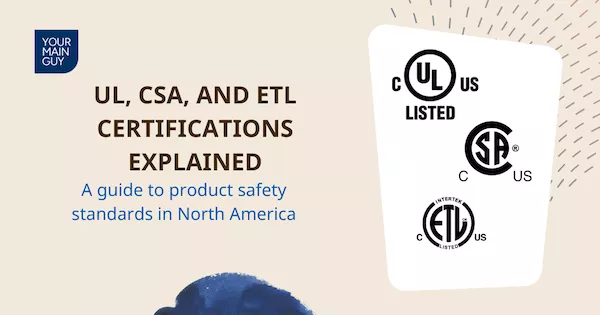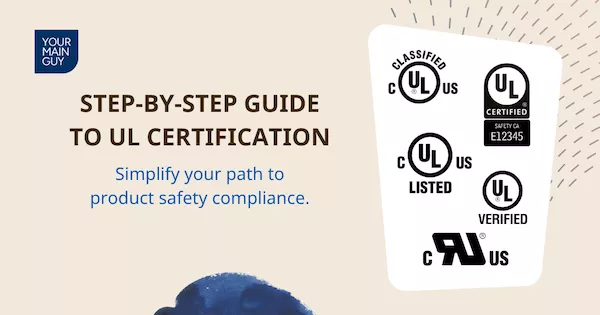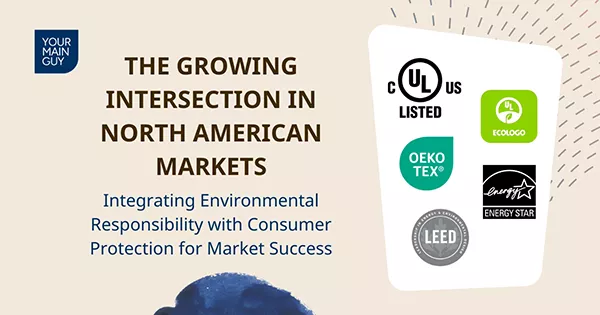Understanding UL, CSA, and ETL: Key Product Safety Certifications in North America
Product safety is crucial in North America. Learn about UL, CSA, and ETL certifications, their differences, processes, and how to choose the right one for your products.
In today's global marketplace, ensuring product safety is paramount for manufacturers, retailers, and consumers alike. In North America, a trio of organizations stands at the forefront of product safety certifications: Underwriters Laboratories (UL), Canadian Standards Association (CSA), and Intertek Testing Services (ETL). These certifications serve as a seal of approval, assuring consumers and regulators that products meet stringent safety standards. This comprehensive guide will delve into the world of UL, CSA, and ETL certifications, exploring their differences, applications, and significance in various industries.
What is Product Safety Certification?
Product safety certifications are third-party validations that confirm a product meets specific safety standards. These certifications play a crucial role in protecting consumers from potential hazards and help manufacturers comply with regulatory requirements.
Today, safety certifications are an integral part of the product development and marketing process. They not only ensure compliance with legal requirements but also build consumer trust and can provide a competitive edge in the marketplace. Understanding the nuances of UL, CSA, and ETL certifications is essential for businesses operating in the North American market.
What is Underwriters Laboratories (UL)?
Founded in 1894, Underwriters Laboratories (UL) is one of the oldest and most recognized safety certification organizations in the world. William Henry Merrill established UL after observing the potential fire hazards at the World's Columbian Exposition in Chicago. Since then, UL has been at the forefront of developing safety standards for a wide range of products.
UL's Certification Process
UL's certification process is rigorous and comprehensive. It typically involves the following steps:
- Application and product submission
- Product evaluation and testing
- Manufacturing facility inspection
- Certification decision
- Follow-up services and surveillance
Types of UL Marks and Their Meanings
UL offers several types of marks, each with a specific meaning:
- UL Listed Mark: Indicates the product has been tested and meets UL's published standards for safety.
- UL Recognized Component Mark: Used for components that are part of a larger product or system.
- UL Classification Mark: Indicates that UL has evaluated the product for specific properties or a limited range of hazards.
- UL Performance Verified Mark: Confirms that UL has tested and verified specific performance claims.
Industries and Products Typically Requiring UL Certification
UL certification is widely required across various industries, including:
- Electrical and electronic products
- Fire protection equipment
- Building materials
- HVAC systems
- Lighting products
- Appliances and consumer electronics
UL's Global Recognition and Influence
While UL originated in the United States, its influence extends globally. Many countries recognize UL certifications, and the organization has established partnerships and accreditations worldwide. This global recognition makes UL certification particularly valuable for companies looking to enter multiple markets.
What about Canadian Standards Association (CSA)?
The Canadian Standards Association, now known as CSA Group, was founded in 1919. Initially focused on creating standards for railroad bridges and electrical equipment, CSA has since expanded its scope to cover a wide range of products and services.
CSA's Certification Process
CSA's certification process is similar to UL's and includes:
- Application submission
- Product evaluation and testing
- Factory evaluation
- Certification decision
- Ongoing surveillance and testing
Types of CSA Marks and Their Meanings
CSA offers several certification marks:
- CSA Mark: Indicates compliance with Canadian standards.
- CSA-US Mark: Shows compliance with both Canadian and U.S. standards.
- CSA Energy Efficiency Verified Mark: Confirms that a product meets energy efficiency standards.
- CSA Star Certification: Used for gas-fired appliances and equipment.
Industries and Products Typically Requiring CSA Certification
CSA certification is commonly required for:
- Electrical and electronic products
- Gas-fired appliances
- Plumbing and construction products
- Personal protective equipment
- Medical devices
- Automotive components
CSA's Role in Canadian and International Markets
While CSA is the primary certification body in Canada, its influence extends beyond Canadian borders. CSA certifications are recognized in the United States and many other countries, making it a valuable asset for companies operating in North America and beyond.
What are Intertek Testing Services (ETL)?
The ETL (Electrical Testing Labs) mark, now owned by Intertek, has a rich history dating back to Thomas Edison's Lamp Testing Bureau in 1896. Intertek acquired ETL in 1996, continuing its legacy of product safety testing and certification.
ETL's Certification Process
ETL's certification process includes:
- Quote request and application
- Product sample submission
- Testing and evaluation
- Certification decision
- Ongoing compliance services
Types of ETL Marks and Their Meanings
ETL offers several marks:
- ETL Listed Mark: Indicates compliance with North American safety standards.
- ETL Classified Mark: Shows compliance with specific properties or a limited range of hazards.
- ETL Recognized Component Mark: Used for components intended for use in other certified products.
Industries and Products Typically Requiring ETL Certification
ETL certification is common in various industries, including:
- Electrical appliances and electronics
- HVAC equipment
- Lighting products
- Building materials
- Automotive components
- Telecommunications equipment
ETL's Position in the North American Market
While ETL may not be as well-known as UL or CSA, it is a Nationally Recognized Testing Laboratory (NRTL) in the United States and is accredited by the Standards Council of Canada (SCC). This recognition makes ETL certification a viable alternative to UL and CSA for many products.
Which Differences and Similarities between UL, CSA, and ETL?
Similarities and Differences in Certification Processes
All three organizations follow similar certification processes, including product testing, factory inspections, and ongoing compliance checks. However, there may be differences in testing methodologies, turnaround times, and costs.
Market Recognition and Acceptance
UL is generally the most recognized certification in the United States, while CSA holds a similar position in Canada. ETL, while less known to consumers, is equally accepted by regulatory bodies and is often chosen for its potentially faster and more cost-effective certification process.
Geographic Coverage and Specializations
- UL: Strongest presence in the U.S., but widely recognized globally.
- CSA: Dominant in Canada, with growing international recognition.
- ETL: Accepted throughout North America, with a growing global presence.
Testing Methodologies and Standards Used
All three organizations typically test to the same standards (e.g., ANSI, ASTM, NFPA) but may have slight variations in their testing methodologies or interpretations of these standards.
What are the Industry-specific Certification Requirements?
Electrical and Electronic Products
Most electrical and electronic products sold in North America require safety certification. UL, CSA, and ETL are all widely accepted, with the choice often depending on the specific product and target market.
Construction and Building Materials
Building codes often specify required certifications. UL and CSA are particularly strong in fire-resistant materials and electrical building components.
Medical Devices
Medical devices typically require certification to specific standards like IEC 60601. All three organizations offer medical device certifications, but manufacturers should check with regulatory bodies for specific requirements.
Automotive Industry
Automotive components often require specialized certifications. While UL, CSA, and ETL all offer relevant services, manufacturers should consult with industry-specific bodies like the Society of Automotive Engineers (SAE).
Home Appliances and Consumer Goods
Consumer products often benefit from the brand recognition of UL or CSA marks, but ETL certification is equally valid from a regulatory standpoint.
How to Choose the Right Certification for Your Product?
When selecting a certification body, consider:
- Target market and regulatory requirements
- Certification costs and timelines
- Specific product category and applicable standards
- Potential for future market expansion
In some cases, obtaining multiple certifications (e.g., UL for the U.S. market and CSA for Canada) may be beneficial, especially for products targeting both markets.
What would be the Future of Product Safety Certifications?
The landscape of product safety certifications is evolving. Key trends include:
- Increased focus on cybersecurity for connected devices
- Growing emphasis on sustainability and environmental impact
- Harmonization of standards across different regions
- Adaptation to rapid technological advancements
As global trade continues to expand, we may see further cooperation between certification bodies and potentially more unified standards across North America and beyond.
Understanding the nuances of UL, CSA, and ETL certifications is crucial for businesses operating in the North American market. While these organizations have different histories and strengths, they all play a vital role in ensuring product safety and compliance. By choosing the right certification for their products, manufacturers can not only meet regulatory requirements but also build consumer trust and gain a competitive edge in the marketplace. As the product safety landscape continues to evolve, staying informed about these key certifications will remain essential for businesses across industries.




